The UFO Events at Minot AFB (one of the best cases ever)
A Narrative of UFO Events at Minot AFB
PART 7
Thomas Tulien
Investigation of UFO Events at Minot AFB
on 24 October 1968
Thomas Tulien
3. Information Unavailable to Project Blue Book
The results of the SAC investigations were not
available to Blue Book investigators, including the pilot and B-52 crewmember
debriefings, radarscope film analysis, and the O-7 break-in investigation.
Little if any information was available regarding the Radar Approach Control
(RAPCON) systems, and Aerospace Defense Command’s (ADC) long-range radar
systems at Minot Air Force Station, located 16 miles south of Minot, ND.[29]
Furthermore, the communications transcript notes the
weather radar detection and location of the UFO in relation to the B-52, though
Col. Werlich seems to remain ignorant of this fact.[30]
During a conversation with Blue Book staff on 31 October, Werlich insists that
the only radar detection of the UFO was by the B-52, stating that ADC “do not
remember having any unidentified paints. The only one I have is the one on the
plane.”[31]
Later, after receiving supplemental information, which included the
transcription, Blue Book staff attempted to contact Werlich twice to request
information on the weather radar detection of the UFO, but ultimately received
no response.[32] The paucity
of information in this respect seems intentional, especially since a target
tracked by multiple radar systems would lend considerable weight to the
argument for an airborne, radar-reflective object.[33]
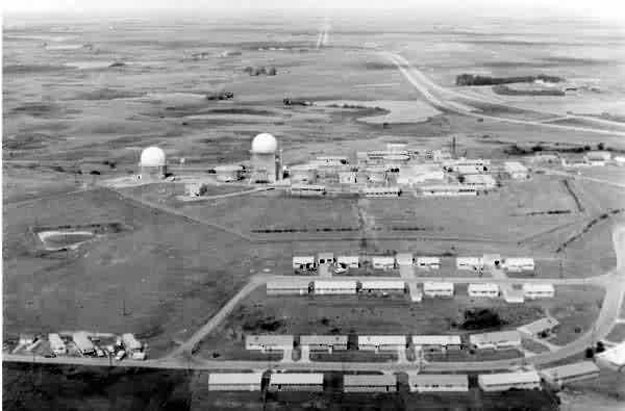
Minot Air Force Station, ND, looking north. The radar
systems consisted of a Westinghouse AN/FPS-26A Frequency Diverse
height-finder and AN/FPS-27 FD search radar, designed to have a maximum
range of 220 nautical miles
and search to an altitude of 150,000 feet. Regarding the AN/FPS 27 FD
system, and Minot AFS, see: http://www.radomes.org/museum/showsite.php?site=Minot+AFS,+ND.
To a certain extent, these omissions can be
understood to be a result of exceedingly restrictive security regulations in
effect at a strategic nuclear airbase such as Minot; particularly since
classification levels for defense radar systems, and all activities pertaining
to the operational delivery of nuclear weapons, were beyond that which Blue
Book was authorized to receive.[34]
For instance, in the early 1960s, as Cold War
tensions reached a climax during the Cuban Missile Crisis, the United States
was completing its “strategic nuclear triad” with the implementation of the
Minuteman, Intercontinental Ballistic Missiles (ICBM), and the Navy’s Polaris,
Submarine-Launched Ballistic Missiles (SLBM), complementing the B-52 bomber
force.[35]
Each force provided the United States with different strategic options to
independently impose unacceptable damages on the Soviet Union. In response, war
planners formed the Joint Strategic Target Planning Staff, in order to
coordinate a National Strategic Target List, and prepare a Single Integrated
Operational Plan (SIOP) for the execution of a nuclear war. The essence of the
first SIOP was the targeting for a massive nuclear strike on military and
urban-industrial targets in the Soviet Union, China, and their allies. To
ensure strict secrecy, an exclusive marker classification — Extremely Sensitive
Information (SIOP-ESI) — was established so that only those with a “need-to-know”
would have access to the documents and targeting plans. Not until the
mid-seventies did the existence of the SIOP become public record, while much of
the information is still highly secret and may never be declassified.[36]

The
Strategic Air Command’s Command Post and global communications center located
several stories below the headquarters building at Offutt AFB, Nebraska. From
the command balcony, the Commander in Chief and his battle staff could execute
the Single Integrated Operational Plan (SIOP) and deploy U.S. strategic forces
in the event of a nuclear war. In August 1960, SAC reached the pinnacle of
power and prestige when Secretary of Defense Thomas Gates instituted the Joint
Strategic Target Planning Staff at SAC headquarters. For a time, there were
more than forty Generals stationed at the base.
All Minot AFB personnel involved in the operational
delivery of nuclear weapons to predetermined targets held SIOP-ESI clearances,
including the B-52 crewmembers, all personnel whose work required access to
weapons and targeting plans, and the capsule crews in the underground missile
Launch Control Centers. This would restrict the information and witness
testimony available to Blue Book investigators, and explain SAC headquarters’
periodic inquiries to Blue Book staff over the course of the investigation.
Initially, from Colonel
J. A. Weyant in the office of the Deputy Chief of Staff for Operations
regarding Blue Book investigative procedures and strict compliance to AFR
80-17. Moreover, by Col. H. V. Pullen, assistant to the Deputy Chief of Staff
for Intelligence, Brig. General Richard Stewart, responsible for managing the
dissemination of Sensitive Classified Information, in which unauthorized
disclosure could be expected to cause exceptionally grave damage to national security.[37]
This concern, particularly regarding Blue Book chief Lt. Col. Hector
Quintanilla’s conclusions, is evident in a telephone conversation with Pullen
on Tuesday, 29 October, when
Col Pullen requested that Col Quintanilla send a preliminary report so that he could give it to General Stewart to get this thing simmered down. Send it SSO [Special Security Office] SAC, attention Col Pullen. He requested that Col Quintanilla hit a little heavy on what happened to other aircraft on occasions like this, this would help to play the issue down.[38]
Col. Werlich was also in contact with SAC
headquarters. During a conversation with Blue Book on Thursday, 31 October, Lt.
Marano complained to Werlich “that SAC was giving us trouble because they
wanted to know what we are doing.” Werlich then informs Marano that before
notifying Blue Book on 24 October, he had phoned SAC requesting technical
assistance for the investigation but “we didn’t get it and we have tried to do
what we could.”[39] Apparently,
when he phoned SAC he spoke with Col Weyant, who had directed him to comply
with AFR 80-17.[40] He then
mentions, “Gen Hollingsworth is interested.” Later in the conversation, he
informs Marano that he has forwarded all of the information he obtained in his
investigation to General Hollingsworth for briefing the second in command, Vice
Commander in Chief, Lt.
Gen. Keith Compton, and the briefing was probably taking place as
they were speaking (3:00 p.m. CST, 31 October).[41]
The next day, Friday, 1 November, Quintanilla
finally responded to Pullen’s earlier request to “play the issue down,”
suggesting that the radar and air-visual observation by the instructor pilot,
Maj. James Partin
AND PERSONNEL ON THE GROUND IS MOST PROBABLY A PLASMA OF THE BALL-LIGHTNING CLASS …. I CONSIDER THE UFO REPORTS AS FAIRLY ROUTINE, EXCEPT FOR THE PLASMA OBSERVATION WHICH IS INTERESTING FROM A SCIENTIFIC POINT OF VIEW. WE WILL STUDY THIS REPORT IN MORE DETAIL WHEN WE RECIEVE THE RAW DATA FROM MINOT.[42]
Nearly a week later, on 7 November, Col. Pullen
demanded that Quintanilla complete his report:
SAC COMMANDER AND STAFF ARE EXTREMELY INTERESTED IN THIS ITEM. REQUEST A COPY OF YOUR REPORT OF THIS INCIDENT BE FORWARDED THIS HEADQUARTERS AS SOON AS POSSIBLE. IF ANY DIFFICULTY IS ENCOUNTERED SECURING RAW DATA OR ASSISTANCE FROM MINOT PLEASE ADVISE. YOUR EXPEDITIOUS HANDLING OF THIS INCIDENT IS APPRECIATED.[43]
Clearly, SAC is closely monitoring the progress and
conclusions of the Blue Book investigation. Moreover, it seems evident they are
purposefully managing the information and data available to the Blue Book
investigation, and thereby facilitating its function to normalize all UFO
reports.
For example, following the B-52 air-radar UFO
encounter, the pilots were preparing to land when they received an order from a
General officer to continue back around the traffic pattern in order to overfly
a stationary UFO and photograph it.[44]
The specific request by the General, or the request relayed by RAPCON and
co-pilot Runyon’s response, should appear in the communications transcript — but
are clearly absent.[45]
McCaslin recalls Runyon’s response to the request:
McCASLIN: My memory is that the tower asked us to go take a visual look at what was out there. I heard the pilot saying things to the tower that made it clear to me that is what they wanted, and he was not too keen to do it. He said something like, ‘Okay, look, I’ll go, I’ll do one visual pattern, and then I’m putting this thing on the ground.’[46]
Furthermore, following 4:21
CDT (0921Z) the time-code references have been omitted for the entire final
circuit of the traffic pattern. Additional omissions include the RAPCON vector
directing the B-52 to turn left onto the 290-degree downwind leg, which is when
the B-52 pilots observed the UFO ahead of the aircraft for several minutes
before turning over it onto the base leg, and apparently any pilot-RAPCON
conversations during the air-visual encounter.[47]
Capt. Runyon recalled conversations with RAPCON and the second loss of radio
transmission during the close approach:
RUNYON: Okay, well [the radio] went off again, because the controllers were asking me, you know, if we had it and so forth. I’m talking to them. Then after we went by it and turned towards the runway the radios came back in. Of course, they had me change and trying different frequencies and everything, but there was [nothing] wrong with the radios.[48]
In 2001, Maj. Partin
recalled the excitement upon viewing the object:
PARTIN: When I described to the crew over the interphone what I was seeing, the navigator, the radar navigator and everybody tried to get up in our lap in the cockpit and — [laughs].[49]
Capt.
McCaslin, down in the belly of the B-52, recalls his apprehension at being
invited up to have a look:
McCASLIN: I heard the pilot say something like ‘[expletive], look at this,’ and they were talking back and forth about it, apparently we flew right over the thing. At one point, I think the Aircraft Commander said, ‘Come on up here and take a look at this thing,’ and I indicated that I was not about to get out of a perfectly good ejection seat and climb upstairs with no parachute to look at whatever this was. Because it occurred to me that if I were someone in a strange place investigating things and this huge aircraft flew over me at a very low altitude — I am not sure what I would have done. I wanted to make sure that I had something that would get me out of the airplane if they took umbrage at that.[50]
Regardless, the communications transcript reads as
if the final go-around of the traffic pattern was merely routine and
uneventful.[51] At the very
least, whoever transcribed the RAPCON communication tapes lacked experience and
proper equipment for accurately displaying the encoded time references.[52]
On the other hand, the omissions correlate specifically to the air-visual
observation of a huge, luminous UFO at very close range by highly qualified
military observers.
------------------------------------
Investigation of UFO Events at Minot AFB
on 24 October 1968
Thomas Tulien
4. Project Blue Book Investigation
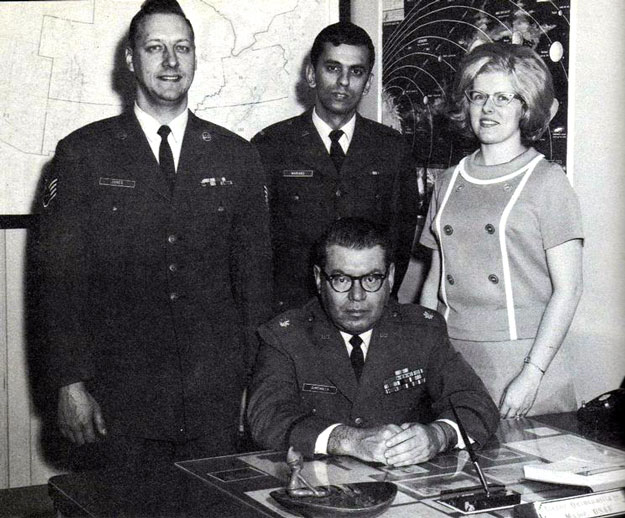
In its later years, USAF Project
Blue Book staff was headed by Lt. Col. Hector Quintanilla, Jr. (seated); with
the assistance of 2nd Lt. Carmon Marano (center standing), duty
officer SSgt. Harold T. Jones, and secretary Marilyn Stanscomb. Major
Quintanilla (promoted during his tenure) took over as head of the project in
August 1963 until its doors finally closed on 30 January 1970.
Background
Throughout the 1950s,
the Air Force was successful in its ongoing public relations campaign. The
turning point came in 1965, with a prolonged wave of sightings that continued
through 1967. A surprisingly large number of cases were reported by scientists
and technically trained observers, and prompted widespread press coverage and
some of the first questioning — if not criticism of the Air Force UFO program.
Public interest grew enormously, and for the first time the scientific
community entered into the debate.
In March 1966, one of the most widely publicized events in the
history of the phenomenon occurred over several nights in Michigan.
Sightings by over 140 witnesses, including sheriff’s deputies and police
officers across numerous counties caused a nationwide furor.
On March 14 and 17, Washtenaw County sheriffs and police in
neighboring jurisdictions reported disc-shaped objects moving at
fantastic speeds, while making sharp turns, diving, climbing, and
hovering. At one point, four UFOs in straight-line formation were
observed, and Selfridge AFB confirmed tracking UFOs over Lake Erie.
Deputies Bushroe and Foster stated: “We would have not believed this
story if we hadn't seen it with our own eyes. These objects could move
at fantastic speeds, and make very sharp turns with great
maneuverability. We have no idea what these objects were, or where they
could have come from.”
On March 20, near Dexter, Frank Mannor and family, and dozens of
other witnesses, reported a domed oval object with a “quilted” surface
and lights in the center and each end, which had landed in a swampy
field. Sheriff Douglas Harvey ordered all available deputies to the
scene. They later chased the flying object in their patrol cars but lost
it in the trees.
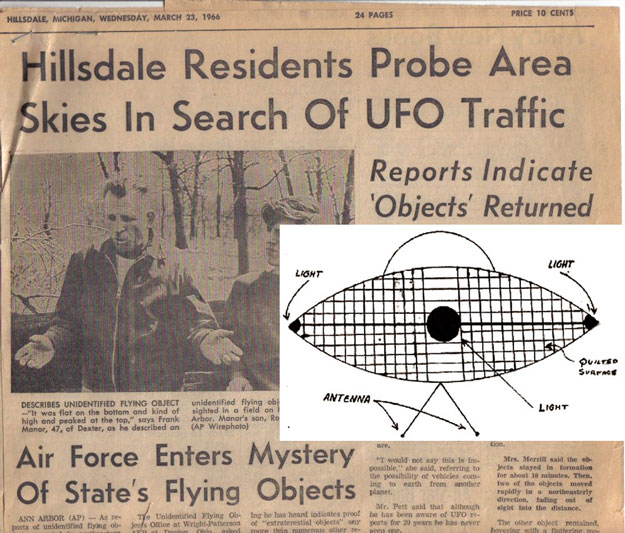
Hillsdale, Michigan Daily News, Wednesday 23 March
1966. Witnesses got together after the sightings at the Washtenaw County
sheriff’s headquarters and composed this drawing of the UFO. Sheriff
Douglas J. Harvey gasped: “If there is such a thing as a flying saucer,
this must be it.” Additional information at cohenufo.org: 1966 Southeastern Michigan UFO Sightings.
During the evening of 21 March at Hillsdale College,
southwest of Ann Arbor, seventeen female students and the college dean watched
a glowing football-shaped object hover in a swampy area. At one point the
object darted toward the women’s dormitory before stopping suddenly and
retreating back to the swamp. The women called Hillsdale County civil defense
director, William Van Horn, who arrived with police to search the area. From
the second floor of the dormitory, they observed the object at a distance of
about 1500 to 1700 feet. After about 10 minutes two dim lights began to grow in
brilliance to red and the white. As the lights became more brilliant the object
would rise to a height of approximately 100 to 150 feet, stop momentarily, and
descend. The object stayed in the area for four hours before vanishing.
The next day, Michigan Congressman Weston Vivian
requested an official investigation, prompting Quintanilla to send Blue Book
scientific consultant J. Allen Hynek to the scene. Three days later, at the
“largest press conference in the Detroit Press Club’s history,” Hynek suggested
that what people had seen “could have been due to the release of variable
quantities of marsh gas,” whereby methane gas released by rotting vegetation is
spontaneously ignited.
The press pounced on the solution, and “swamp gas”
became an object of wide-ranging ridicule and humor across the nation. The New Yorker was openly derisive:
We read the official explanations with sheer delight, marveling at their stupendous inadequacy. Marsh gas indeed! Marsh gas is more appropriate an image of that special tediousness one glimpses in even the best scientific minds.
The uproar was so adverse,
that then Michigan Congressman and House Republican minority leader Gerald R.
Ford formally called for Congressional hearings.
In April 1966, the House Armed Services Committee
acted on Ford’s suggestion and held the first open Congressional hearing on the
subject. Facing mounting
discontent with the Air Force’s UFO policy, Secretary of the Air Force Harold
D. Brown directed the Air Force Office of Scientific Research to locate a
university to conduct an independent investigation of the UFO phenomenon. On 7
October 1966, the Air Force publicly announced that the University of Colorado
had accepted the UFO study contract, under the direction of the eminent
physicist, and former head of the National Bureau of Standards, Dr. Edward U.
Condon.
While the conclusions of the two-year study would
eventually lead to the long-anticipated closing of Project Blue Book, for the
time being, the Air Force was relieved of its public relations pressures as the
focus shifted to the University of Colorado UFO study, and for the most part,
the press and public adopted a wait-and-see attitude.[53]
Air Force Regulation 80-17
In September 1966, responsibility for the UFO
program transferred out of the intelligence community to the Deputy Chief of
Staff, Research and Development. This move put Blue Book within the Air Force
scientific community, supported by the Foreign Technology Division (FTD) in the
Air Force Systems Command at Wright-Patterson AFB, Ohio. A revised UFO
regulation, issued on 19 September as AFR 80-17, reflected the official change
in attitude concerning the importance of UFOs, while allowing Blue Book to
submit UFO reports directly to the University of Colorado UFO study.
This regulation establishes the Air Force program for investigating and analyzing UFOs over the United States. It provides for uniform investigative procedures and release of information. The investigations and analyses prescribed are related directly to the Air Force's responsibility for the air defense of the United States. The UFO Program requires prompt reporting and rapid evaluation of data for successful identification. Strict compliance with this regulation is mandatory.[54]
The program objectives were
two-fold, omitting the third objective in previous regulations concerning the
mandate to reduce the percentage of unidentifieds to the minimum:
To determine if the UFO is a possible threat to the United States and to use the scientific and technical data gained from study of UFO reports. To attain these objectives, it is necessary to explain or identify the stimulus which caused the observer to report his observation as an unidentified flying object (AFR 80-17, Sec. A, par. 2).
To
implement the program, UFO reports were referred to the nearest Air Force base
and each base commander was required to provide an investigative capability. In
this case, Minot AFB Commander Col. Ralph Kirchoff designated Lt. Col. Arthur
Werlich, head of the 862nd Combat Support Group, Operations
Division, as liaison to the UFO program. Werlich’s primary responsibility was
to collect data, collate a formatted list of Basic Reporting Data, and provide
his initial analysis and comment on the possible cause
or identity of the stimulus in a supporting statement. He will make every
effort to obtain pertinent items of information and to test all possible leads,
clues, and hypotheses. The investigating officer who receives the initial
report is in a better position to conduct an on-the-spot survey and follow-up
than subsequent investigative personnel and analysts who may be far removed
from the area and who may arrive too late to obtain vital data or information
necessary for firm conclusions. The investigating officer's comments and
conclusions will be in the last paragraph of the report submitted through
channels (Sec. C, par. 10).[55]
This was Col. Werlich’s first official UFO investigation.
Notifying Blue Book
Following
the UFO events on Thursday, 24 October, in the afternoon Col. Werlich contacted
SAC headquarters requesting technical assistance for his investigation. Denied
assistance, Col. J. A. Weyant in Operations directed him to act in accordance
with AFR 80-17. At 4:30 p.m. (CDT), he telephoned Project Blue Book duty
officer SSgt. Harold Jones at Wright-Patterson AFB, Ohio, reporting that:
The crew of a B-52 had sighted and photographed an UFO and that the Base Commander and Major General Nichols of the 15th Air Force were both interested.[56]
Jones called assistant Lt.
Carmon Marano, who returned to the office to inform Blue Book chief Lt. Col.
Hector Quintanilla before phoning Werlich back at Minot AFB. Since it was such
an unusual sighting, Werlich wanted to know if Blue Book could help in any way.
Marano then asked him for the details of the sighting.
At about 0300 hours local, a B-52 that was about 39 miles northwest of Minot AFB and was making practice penetrations sighted an unidentified blip on their radar. Initially the target traveled approximately 2-1/2 miles in 3 sec — or about 3,000 mph. After passing from the right to the left of the plane it assumed a position off the left wing of the 52. The blip stayed off the left wing for approximately 20 miles at which point it broke off. Scope photographs were taken. When the target was close to the B-52 neither of the two transmitters in the B-52 would operate properly but when it broke off both returned to normal function.
At about this time a missile maintenance man called in and reported sighting a bright orangish-red object. The object was hovering at about 1000 ft or so, and had a sound similar to a jet engine. The observer had stopped his car, but he started it up again. As he started to move the object followed him then accelerated and appeared to stop at about 6-8 miles away. The observer shortly afterward lost sight of it.
In response to the maintenance man’s call the B-52, which had continued its penetration run, was vectored toward the visual which was about 10 mile northwest of the base. The B-52 confirmed having sighted a bright light of some type that appeared to be hovering just over or on the ground.
Fourteen other people in separate locations also reported sighting a similar object. Also, at this approximate time, security alarm for one of the sites was activated. This was an alarm for both the outer and inner ring. When guards arrived at the scene they found that the outer door was open and the combination lock on the inner door had been moved.[57]
Quintanilla then requested information on other
radars and control tower personnel observations; observational data from the 14
witness sightings to determine if they were looking at the same object, or
stellar bodies; and whether anyone had observed a physical object. Finally, it was determined that exact
time sequences for the events were necessary and Werlich agreed to gather the
information.
Over the next four days, Werlich gathered and
collated the information necessary to complete the formatted list of Basic
Reporting Data prescribed in AFR 80-17. On Friday, 25 October, the November
security personnel returned to base, and both Airman First Class Joseph
Jablonski and A1C Gregory Adams completed the AF-117 Sighting of
Unidentified Phenomena Questionnaire.[58] On Saturday, November-Flight Security
Controller SSgt. James Bond, and Oscar-FSC SSgt. William Smith completed
AF-117s.[59] During his
interview, Smith recalls informing Werlich of numerous, earlier reports of
lights observed near the Oscar-2 missile silo — up near the Canadian border. He
maintains that afterwards Werlich took a camper vehicle and spent some time up
at O-2. What came of this is unknown. There is no mention to Blue Book, and any
results were never reported back to Smith.[60]
On Monday, 28 October, the missile maintenance team
of A1C Robert O’Connor and A1C Lloyd Isley recall being awakened early in the
morning and instructed to report to Base Operations. Isley recalls being
informed by Werlich that a B-52 had picked something up on radar, but the main
purpose was to have them complete the AF-117’s.[61]
In the Basic Reporting Data, Werlich includes B-52
navigator Capt. Patrick McCaslin, and the non-crew pilot Maj. James Partin in
his list of military observers, though none of the B-52 crewmembers were
interviewed. Partin completed an AF-117 on Wednesday, 30 October, two days after Werlich submitted the Basic Reporting Data to Blue
Book.[62]
Werlich also declared,
NINE OTHER MILITARY MEMBERS STATED THAT THEY VISUALLY OBSERVED AN OBJECT, HOWEVER, ONLY ONE [OF] THESE WAS IN A POSITION TO CONTRIBUTE ANY PERTINENT INFORMATION.[63]
He does not name these
additional witnesses, though presumably they include security personnel at
Mike-1, Juliet-1, and the Security Alert Team at Oscar-1, identified in the
list of observers by the Wing Security controller in his summary.[64]
In any case, it is unfortunate that he didn’t at least record basic
observational data, specially those at diverse locations such as Mike-1,
Juliet-1, and O-6; which, combined with observations at N-1, N-7, and O-1,
would have provided a means of triangulation to determine whether they were all
observing the same object. Surely, it would have resolved any probability they were observing a fixed celestial object.[65]
SAC Headquarters Intervenes
At 11:15 a.m. (EST) Monday, 28 October, Blue Book
duty officer SSgt. Jones received a call from Col. J. A. Weyant in Deputy Chief
of Staff/Operations at SAC headquarters inquiring about the procedures by which
Blue Book receives and investigates UFO reports, while underscoring that
‘The investigator [Werlich] would handle it in accordance with AFR 80-17.’ Sgt Jones told him that was right. Col Weyant then said, ‘then you can’t do anything until you receive their report,’ Sgt Jones said, ‘that’s right.’[66]
Weyant asked Jones if there have been “any other
reports for that period of time from that area” and requested that whoever was
responsible for handling the report give him a call, before ending the
conversation. Shortly after, at 12:50, Weyant phoned again and spoke with Lt.
Marano, wanting to “know if we (Lt Marano) had received any indication of any
other reports from Minot. Marano informed him that we haven’t received any
other reports from that area.” After establishing that both Marano and
Quintanilla had spoken with Werlich, who had agreed to do the investigation,
Col Weyant said he was trying to determine whether ADC [Minot AFS] had any known phenomena on radar. Col Weyant asked Lt Marano if we [Blue Book] ever participated in any investigations. [Marano responded] Very seldom do we ever go out in the field. As far as Lt Marano was concerned Col Werlich was quite competent and he did not feel that Col Werlich needed any additional help at this time.
What follows is a somewhat cryptic comment indicating that Weyant had already
been in contact with Werlich:
Col Weyant said he gave Col Werlich the guidance and he guessed that Col Werlich got our telephone number out of the regulation. Col Weyant said he felt that we couldn’t give him any more information so he ended the conversation.[67]
Basic Reporting Data and Format
Late on
Monday, 28 October, Col. Werlich completed the Basic Reporting Data section per
AFR 80-17. At 10:28 p.m. (CST), he electronically transmits the eight-page
report via Teletype (TWX) to Project Blue Book (FTD), and several other Air
Force agencies specified in the regulation.[68]
Supplying Blue Book staff with data and information necessary to prepare the
final case report fulfilled Werlich’s principal responsibility under the
regulation. However, over the next two weeks Blue Book staff continued to
request supplemental information.
Tuesday morning, 29 October, Lt. Marano phoned Minot
hoping to speak with Werlich, who was unavailable since he was flying that
morning. He then spoke with a Mr. Carber who informed him that the UFO report
was completed and “sent out this morning or would be sent out today.”[69]
Earlier in the day, it appears Blue Book received an
inquiry from SAC headquarters, since at 3:30 p.m. Quintanilla telephoned
Colonel H. V. Pullen, assistant to the Deputy Chief of Staff for Intelligence,
who requested “a brief rundown on the Minot sightings.” Quintanilla began to
wander through possible, if tenuous, explanations for the various observations,
suggesting that the B-52’s radio transmitter might have caused the radar echo,
“since it occurred for only a short period of time.” Then, referring to the
lengthy sighting period, “I feel some of the men were looking at celestial
bodies” because of a temperature inversion in the lower atmosphere causing the
stars to scintillate. He adds, “there were a number of stars in the area at the
time.” Pullen then said that he
would “like to receive a preliminary report giving a quick look.” Quintanilla
consented to the request, while explaining that the sightings took place over a
period of more than two hours, which “is too long to make an accurate report.”
Finally submitting he was “pretty sure” the B-52 radar return “was either
caused by an internal radar malfunction that also caused the blip or because of
the [temperature] inversion he might have also picked up an anomalous blip.”[70]
Pullen asked whether they had sent anyone to Minot to investigate, to which
Quintanilla responded,
We did not send anyone up because I only have four people on my staff, myself, an assistant, a secretary and an admin sergeant. I talked to Col Werlich for over thirty minutes and since this didn’t appear [too] unusual I didn’t send anyone up. Col Pullen requested that Col Quintanilla send a preliminary report so that he could give it to General Stewart to get this thing simmered down. Send it SSO SAC, attention Col Pullen. He requested that Col Quintanilla hit a little heavy on what happened to other aircraft on occasions like this, this would help to play the issue down.[71]
Early Wednesday morning, 30 October, Lt. Marano
phoned Minot Base Operations to learn that Col. Werlich was still flying. He
spoke with a Sgt. Hoy, requesting that Hoy have Werlich obtain additional
information and TWX it to him. The first part is a request to, “Have the
navigator [McCaslin] accompany someone and go out and interview the individual
observers at the missiles sites.” By this time, Werlich had already interviewed
principal ground witnesses, though he had not forwarded the completed AF-117 Sighting
of Unidentified Phenomenon Questionnaires.
Marano also requested
statements from aircraft personnel regarding the B-52 radar and air-visual
sighting (which may have prompted Werlich to have Partin complete his AF-117
that same day). He also requested information on other radar systems in the
Minot area, if additional radars or ECM (Electronic Counter Measures) onboard
the B-52 painted anything, and whether the equipment was checked out by ground
maintenance after the B-52 landed. Werlich had suggested in the Basic Reporting
Data that “the Oscar-7 alarms could be attributed to a circumstantial effort of
pranksters,” and Marano requested “a statement that the missile sites had been
broken into before and what results.” Finally, he requested that additional
materials be sent by mail, including a map of the area; a plot of the B-52 flight
path from 02:58 CDT until landing with time sequence markings; the AF-117
reports from each observer; and copies of the B-52 radarscope photos.[72]
On Thursday afternoon, 31 October, Werlich
telephoned Blue Book. Over the course of a long conversation, he endeavors to
address all of the supplemental questions solicited by Marano, while qualifying
his comments and conclusions in the Basic Reporting Data. At the very end of
the conversation, he says that this would be his last communication.
Col Werlich said he would be flying tomorrow and Monday. Col Werlich said he had done the initial investigation in accordance with the regulation and I’m at the limits of my capabilities. Col Werlich I can send supplemental data and will if we make our desires known and inform what specific information we need. Col Werlich said we were hoping for technical assistance and we didn’t get it. Lt Marano told Col Werlich we felt that he was doing an adequate job as far as technical data. Col Werlich said this was his first report and didn’t know how to ask questions or anything and he had spent too much time on it already.[73]
With the end of Werlich’s involvement came the end
of the evidence available to Quintanilla as he formulated his final case
report. At this point, we will review Werlich’s data and conclusions in the
Basic Reporting Data, along with his qualifying statements in response to Blue
Book’s request for supplemental information.
--------------------------------------
Investigation of UFO Events at Minot AFB
on 24 October 1968
Thomas Tulien
5. Reviewing Werlich’s Data and Conclusions
Col. Werlich organized his comments and conclusions
at the end of the Basic Reporting Data into six sections (pp. 5-8):
- The initial ground observations and subsequent activities (5).
- The B-52 activities, including radar and air-visual observations until landing (5-7).
- The Oscar-7 break-in and SAT investigation (7-8).
- The observation of two similar objects by the ground observers (8).
- Comments that the ground observations were probably of the B-52 (8).
- Four occurrences that cannot be explained:
- Cause of the radar echo;
- Cause of the loss of B-52 UHF radio transmission;
- Cause of B-52 air-visual observation and simultaneous ground observation in the same location;
- Cause of Oscar-7 break-in (8).
He avoided commenting on the
cause or stimulus of the B-52 radar and air-visual encounters, and evidence of
two similar UFOs. Instead, the primary focus of his analysis was an attempt to
demonstrate that the majority of ground observations were actually
misidentifications of the B-52.
Initial Ground Observations
Werlich’s first comment is a very brief summary of
the initial ground observation and events up to the dispatching of the
November-Security Alert Team to N-7.
(1) THE FIRST SIGHTING OF THE OBJECT (A BRIGHT LIGHT) WAS MADE BY AIRMAN O CONNOR AND ISLEY WHILE DRIVING TO NOVEMBER 7 MISSILE SITE. THEY REPORTED THIS SIGHTING TO THE WING SECURITY CONTROLLER OVER THE VEHICLE RADIO. WING SECURITY CONTROLLER THEN ALERTED ADJACENT FLIGHT SECURITY CONTROLLERS TO THE SIGHTING. WSC ALSO NOTIFIED THE 91ST MISSILE WING COMMAND POST AND THE BASE OPERATIONS DISPATCHER. THE BASE OPERATIONS DISPATCHER NOTIFIED THE TOWER OPERATOR AND RAPCON AND ARRANGED A PHONE PATCH TO THE VEHICLE. HE INSTRUCTED AIRMAN OCONNOR TO DESCRIBE WHAT WAS HAPPENING AND THEN PROCEEDED TO MAKE A LOG OF EVENTS CONTAINING TIME AND CIRCUMSTANCES. SSGT BOND SENT A SECURITY ALERT TEAM, AIRMAN ADAMS AND JABLONSKI, FROM NOVEMBER 1 SITE TO ASSIST AT NOVEMBER 7.[74]
In the
data section, Werlich notes the time period of the observations as “24 OCT
68-0800Z (0300 CDT) UNTIL APPROXIMATELY 1015Z (0515 CDT),” and length of time
as “[VISIBLE] 2 HOURS, 15 MINUTES.”[75]
Based on information in the AF-117’s, both the maintenance team of A1C O’Connor
and A1C Isley, and Oscar-Flight Security Controller SSgt. Smith reported
independently at 2:30 a.m., while the Camper Team (and Target Alignment Team)
at Oscar-6 reported their observation to Smith at 2:15.[76]
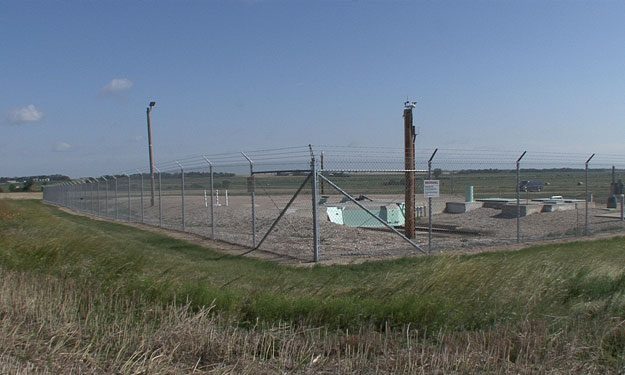
O-6 Launch Facility located 19 miles north of Minot AFB,
looking northeast. The underground Launch Support Building is to the right of
the launcher closure, or “blast door” covering the missile silo. According to
Smith, the camper team was providing security for the targeting team working
underground in the missile silo when they observed a large glowing object go
down behind some trees not far away. Concerned about an unidentified object
near the exposed nuclear weapon, they closed the site and returned to base. During
the Blue Book investigation, Werlich ignored the ground observations reported
prior to 3:00 a.m.
Werlich also has the
reporting sequence somewhat misconstrued. At 2:30, O’Connor and Isley reported
their initial observation while driving “5 MILES NORTH OF GRANO” to base
Transportation Control (not the “WING SECURITY CONTROLLER”), who forwarded
their call to the Base Operations Dispatcher.[77]
At the same time, Smith reported his observation to SSgt’s Neal and Underhill
at the 91st Strategic Missile Wing, Security Control (WSC).[78]
The dispatcher notified RAPCON, established a phone patch to the maintenance
team's vehicle radio, and proceeded to log the events beginning at 0800Z (3:00
a.m.). In addition, after arriving
at N-7 and entering the Launch Support Building adjacent to the silo, O’Connor
reported to November- Flight Security Controller SSgt. Bond, who reported the
maintenance team’s observation at 3:08 to Technical Sergeant Bowles at WSC.[79]
It appears as though
Werlich is ignorant of the data and information contained in the AF-117s. As a
result, he simply assumes that the maintenance team reported the first
observation at 3:00, perhaps based on the first entry in the Base Operations
dispatcher’s log at 0800Z. In addition, the length of time that a UFO was
visible and reported is actually over 3 hours (2:15-5:18 [5:34]).[80]

At 2:15, the Camper Team reported a glowing object
near O-6 to SSgt. Smith at O-1. (Blue Book investigators did not
interview the Camper Team, or Target Alignment Team). At 2:30, Smith
observed the UFO in the south, at the same time the maintenance team of
O’Connor and Isley reported a UFO in the east. While driving south to
N-7, the UFO appeared to pace them while growing brighter. When they
arrived at N-7 the “big ball of white light” was “moving in a large
circular area to the south.” They reported the observation to SSgt. Bond
at November-1. At 3:08, Bond and his security alert team observed the
self-luminous object alternating colors in the SSE, at an estimated
distance of 10-12 miles. Bond dispatched Jablonski and Adams to assist
the team at N-7. Note that the UFO traveled more than 10 miles to the
southwest during the time O’Connor and Isley were driving to N-7.
Werlich’s second comment
is a summary of the events concerning the return of the B-52 also at 3:00 a.m. (CDT), i.e., “THE AIRCRAFT INITIALLY
ARRIVED …. AT ALMOST THE SAME TIME AS THE FIRST GROUND SIGHTING.”
(2) AT THE TIME OF THESE EVENTS, A B-52 WAS IN THE LOCAL AREA. THE AIRCRAFT INITIALLY ARRIVED IN THE AREA ON A 50 [NAUTICAL] MILE RADIUS CLEARANCE WITH A BLOCK ALTITUDE OF FL210 TO FL230 AND BEGAN VARIOUS INSTRUMENT PRACTICE MANEUVERS INCLUDING A VERTICAL “S” PATTERN. THIS TOOK PLACE AT ALMOST THE SAME TIME AS THE FIRST GROUND SIGHTING.[81]
The precise time the B-52 arrived back at Minot is
never stated, nor the locations established before the beginning of the
communications transcript at 3:34 [3:44], when the B-52 is on low approach over
the runway.[82] B-52
Navigator Capt. Patrick McCaslin recalls that they returned from Grand Forks
AFB, ND, east of Minot AFB around 3:00.[83]
Upon returning, Co-pilot Capt. Bradford Runyon recalls practicing high-altitude
maneuvers, most likely to the east of Minot over open country:
RUNYON: I think we did some high altitude work probably some vertical S’s, maybe some steep turns, some 60 degree bank turns.
INTERVIEWER: So, that’s at 20,000?
Jan Aldrich, Director of Project 1947, and Brad Runyon.
RUNYON: Right, at higher altitude, like for the vertical S’s we might have gotten a block from 20 to 30; or 30 to 40,000 feet for that.
INTERVIEWER: And that is what?
RUNYON: Just, you know, go up and down, certain air speeds, certain rates of descent . . .. Then do 60-degree banking turns, that’s high altitude …. We are probably at 40,000.
INTERVIEWER: So nobody could see you up there, and you don’t have your landing lights on?
RUNYON: No, no way, and we were probably not over our base anyway — were out to the middle of nowhere. So yeah, the higher the altitude the harder it is to hold the airplane up in a steep bank.[84]
Clearly, the original sightings could not have been
the B-52, particularly since they began 45 minutes before the B-52 returned to the Minot area. In addition,
when the B-52 arrived under the control of RAPCON on a 50 nautical mile radius
clearance, it remained at altitudes well above 20,000 feet practicing high-altitude
maneuvers. The B-52’s landing lights would not be on; moreover, weather
conditions specified a heavy haze and overcast from about 10,000 to 20,000
feet.[85]
It is most likely the B-52 remained east of Minot AFB until after 3:30, when it
would be southeast on a heading of 290 degrees in preparation for the descent
from FL200 [Flight Level 20,000 feet] and low approach over the runway at 3:44.
Following this, the location of the B-52 is known until its terminal landing at
4:40. Nevertheless, Werlich informed Marano on Thursday:
The courses were quite varied over a couple hours and the aircraft took many courses. It will be interesting to crosscheck its path with RAPCON versus the ground observers. Most of the original sightings were of the aircraft.[86]
Later in the conversation,
apparently feeling a need to justify his position, Werlich told Marano that
he was trying to take a positive approach towards this investigation. Almost 80 per cent were looking at the B-52. If you take a look at an aircraft at 20,000 ft, then you wouldn’t see much but I’m to place logic in that it was there and what they saw was there. There is enough there that it is worth looking at. Nobody can definitely say that these people definitely saw the aircraft, but within reason they probably saw it.[87]
In his fifth comment, written several days before
his conversation with Marano, Werlich’s official record on the matter is much
less ambiguous:
(5) IN COMPARING THE AIRCRAFT ACTIVITY AND TIMES CONTAINED ON THE RAPCON TAPE RECORDINGS WITH THE BASE OPERATIONS DISPATCHER’S LOG OF GROUND OBSERVATIONS, IT IS ENTIRELY POSSIBLE AND HIGHLY PROBABLE THAT THE INITIAL SIGHTING AND SUBSEQUENT ACTIVITIES OF THE OBJECT WERE IN FACT THE B-52 ACCOMPLISHING UPPER AIRWORK.[88]

The B-52 arrived from the east at the 50-nautical mile
clearance around 3:00, and remained at high-altitude practicing instrumented
maneuvers. After 3:30, the B-52 would be southeast of the base on approach, and
at 3:44 on low-approach over the runway requesting clearance to the WT fix. Given
clearance to FL200, RAPCON then requested, “On your way out to the WT fix look
out toward your 1:00 position for the next 15 or 16 miles and see if you see
any orange glows out there… Somebody is seeing flying saucers again.”
The second part of the comment, when compared to the
brief notations in the Base Operations Dispatcher’s log, offers some
possibility that the observers were misidentifying the B-52. For example, Werlich
noted:
[5] LATER SIGHTINGS OF BRIGHT LIGHTS AND FLASHING GREEN AND WHITE LIGHTS ACCOMPANIED BY A LOW JET ENGINE SOUND CORRELATES WITH THE B-52 MAKING A VOR PENETRATION, LOW APPROACH AND MISSED APPROACH. PORTIONS OF THE MANEUVER ARE ACCOMPLISHED WITH THE AIRCRAFT LANDING LIGHTS ON. THE HAZE AND LAYERED CLOUD CONDITIONS COULD HAVE DIFFUSED LIGHT SOURCES AND MADE IDENTIFICATION DIFFICULT.[89]
Following are the pertinent notes in the
dispatcher’s log for comparison. Bear in mind, after 3:30, the B-52 is high in
the southeast on descent to the runway, and on low approach directly over the
runway at 3:44. Moreover, overcast weather conditions were only from cloud tops
at 24,700 down to 9,000 feet. Below the air was cool and clear with excellent
visibility at 25 statute miles.[90]
For example,
3:30. Just are in sight now when it passed over site it looked like two high headlights. Moving real slow when oversight [sic] — could hear engines.
3:33 . Disappeared – moved S/E to far from eyesight.
3:36 . Disappeared for three minutes then reappeared. Same spot and moving back toward N-7.
3:38 . Coming out of S/E once more.
3:40 . Hovering 3 miles away 1 to 2000 feet very dim white light.
3:41 . Moving toward N-7 again, light getting brighter. Hovering.
3:42 . In one position.
3:44 . White lights went out, green light on and moving rapidly now. Green light gone out and white light coming back on.[91]
Although the brief second-hand notations by the
dispatcher are difficult to interpret, some of the descriptions present a
possibility that the observers were reporting the B-52. On the other hand, these
few minutes are the only time during the entire reporting period when a
possible correlation exists. Moreover, what is particularly striking is the
uniformity in the UFO descriptions from observers at diverse locations and
perspectives, which do not suggest an aircraft. All of the reports describe a
very large, self-luminous, round or
oval-shaped object, which alternated colors from a very bright white to
orangish-red to occasionally green, with an ability to hover, and change
direction and speed abruptly.
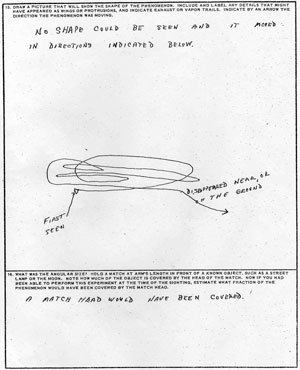
SSgt. James Bond’s AF Form 117 Questionnaire
(6). At
3:08, he observed the UFO in the south-southeast (2) about 10-12 miles
away (7). His final observation was in the southwest (2) where
it “appeared to land and slowly changed to a dim green, after about 15
minutes
it disappeared (gradually)” (5). Elapsed time was 2 hours and 26 minutes
(3). A match head at arm’s length is equal to about 23 minutes of arc.
At 10-12 miles, the size of the object would
be about 350-420 feet.
A. DESCRIPTION OF THE OBJECTS. (1) SHAPE WAS DESCRIBED BY VISUAL SIGHTING AS “JUST ABOUT ROUND, A LITTLE OBLONG IF ANYTHING.” THE SHAPE ON AN AIRBORNE B-52 RADAR SCOPE WAS VERY SHARP AND IRREGULAR AND AT TIMES RECTANGULAR. (2) [Size compared to a known object]. VISUAL SIGHTING COMPARED OBJECT SIZE TO BE EQUAL TO THE SUN, VERY LARGE, TOO BIG FOR AN AIRCRAFT. RADAR SIGHTING DESCRIBES THE SIZE ON THE SCOPE TO BE LARGER THAN THAT OF A KC-135 DURING AERIAL REFUELING. (3) COLOR WAS A VERY BRIGHT RED ORANGE MOST OF THE TIME. (4) THE INITIAL SIGHTING WAS ONE OBJECT. THE ONE OBJECT WAS JOINED BY ONE OTHER LIKE OBJECT FOR A SHORT TIME. THE AIRBORNE RADAR SIGHTING WAS A SINGLE RETURN ON THE SCOPE. (5) THE TWO OBJECTS, WHEN TOGETHER DID NOT RESEMBLE A FORMATION AS SUCH. (6) [Any discernible features or details]. WHEN VIEWED FROM ABOVE BY A B-52 CREW, THE OBJECT [HAD A] FAINTLY WHITE OBLONG HALO ON ONE SIDE WITH AN ORANGE SPOT ON THE OTHER SIDE AND THE BODY APPEARED TO BE A BRIGHT WHITE LIGHT.[92] ONE SOURCE DESCRIBED THE OBJECT, AS SEEN FROM THE GROUND ALMOST OVERHEAD, TO BE SIMILAR IN GENERAL OUTLINE TO A STING RAY FISH. (7) [Tail, trail or exhaust]. NOT OBSERVED. (8) [Sound]. WHEN ALMOST OVERHEAD, A LOW, MUFFLED JET ENGINE SOUND WAS HEARD. THIS OCCURRED TWICE DURING THE SIGHTINGS. (9) [Other pertinent or unusual features]. THE ABILITY TO HOVER AND TO CHANGE DIRECTION AND SPEED ABRUPTLY.[93]
B-52 Air Radar Encounter

B-52 Aircraft Commander, Pilot, Captain Don Cagle;
Co-pilot, Capt. Bradford Runyon, Jr.; Radar Navigator, Major Charles “Chuck”
Richey (dec.); Navigator, Capt. Patrick McCaslin; Electronic Warfare Officer,
Capt. Thomas Goduto; and Gunner, Technical Sergeant Arlie Judd, Jr. All
crewmembers were rated instructors in their respective positions, establishing
them as one of the top crews at Minot AFB in 1968. During this particular
mission, there was an additional pilot onboard from another B-52 crew, Maj.
James Partin, being evaluated by Cagle. When it became apparent that the crew
was being asked to look for a UFO, Cagle dismissed himself from the flight deck
leaving Partin and Runyon in charge for the remainder of the flight.
At 3:34 [3:44], the Transcription of Recorded
Conversations commences between the B-52 pilots and Minot AFB, Radar Approach
Control (RAPCON); however, the first entry at 3:30 [3:40] is the curious statement “Controllers received information on UFO 24 miles
NW.”[94]
This location is in Mike-Flight, about 7 miles west-northwest of N-7. At the
time, the observers at N-7 were reporting a UFO in the southeast, while the
B-52 was southeast of the base on approach to the runway. There are no other
reports of a UFO in this location, and the source of the information is not
identified.[95]
Werlich continues in his comment section:
[2] AFTER A VOR PENETRATION, LOW APPROACH AND MISSED APPROACH TO RUNWAY 29 AT MINOT AFB THE AIRCRAFT CLIMBED TO FL200 ON A HEADING OF 292 DEGREES.[96]
At 3:44, on low approach to
the runway, the B-52 pilots request clearance to the TACAN initial approach
fix, referred to as the “WT fix,” 35 nautical miles northwest of the base.
RAPCON instructs them to climb on a heading of 290 degrees and maintain 5000
feet. At 3:45, they are provided clearance to FL200, then following:
And JAG 31 on your way out to the WT fix request you look out toward your 1:00 [o’clock] position for the next 15 or 16 miles [in the direction of N-7] and see if you see any orange glows out there… . Somebody is seeing flying saucers again.[97]
As the B-52 climbed up into the overcast to 20,000
feet, for the next 7 minutes there are no communications with the controllers
until 3:52, when RAPCON alerted the pilots that “the UFO is being picked up by
the weathers [sic] radar also, should be
your 1:00 [o’clock] position three miles.” Co-pilot Runyon responded, “We have
nothing on our airborne radar and I’m in some pretty thick haze right now and
unable to see out that way.”[98]
At the time, the B-52 was still heading out to the
northwest and in the early stages of completing a standard 180-degree right
turnaround back over the WT fix. B-52 Navigator Capt. McCaslin asked Maj.
Richey to switch to Station Keep mode, in which the radar coverage is elevated
and concentrated close to the aircraft. Shortly after, he recalls:
McCASLIN: At some point on the way out to the nav aid [WT fix], I saw a weak — off to our right, maybe 3 miles out, I saw a weak return, one scan. The next scan was a very strong return about 3 miles off our right wing, which meant to me that something had either climbed into the radar energy, which was why it would be weak as it entered it, and then was about co-altitude in the next sweep; or it could’ve descended into it, don’t know which. But it was clear that something was out there. It was as big or bigger than a KC-135. My impression was it was a larger return than the KC-135 gave me. So I called the pilots and said, ‘There’s traffic off our right wing at 3:00.’ Looks like co-altitude and nobody saw anything; so, I kept watching this thing. The pilot’s said, ‘Keep us advised,’ and I may have called them a time or two and said, ‘It’s still out there.’ [99]
In the data section Werlich
notes the
POSITION OF AIRCRAFT DURING AIR-ELECTRONIC OBSERVATION: INITIAL SIGHTING POSITION WAS 38 NAUTICAL MILES NW OF THE DEERING TACAN 300 DEGREES RADIAL, FL200.[100]
As the B-52 banked around the wide turn, the UFO
maintained its distance, traversing six miles to the northeast outside of the
B-52 turn radius; or to a position three miles off the left wing after the B-52 completed the turnaround. McCaslin recalls:
McCASLIN: I can’t believe that I would not have advised the pilots, you know, ‘we’re going to be making a right turn in the direction of this thing,’ and it was, ‘Keep us advised.’ So they started their turn back to the VOR [WT fix]. My clear memory is as we turned back this return moved out at the same rate we were turning in — it moved out to the northeast — and by the time we rolled back out headed southeast to start the approach it was 3 miles off our left wing, and I advised the pilots of that.[101]
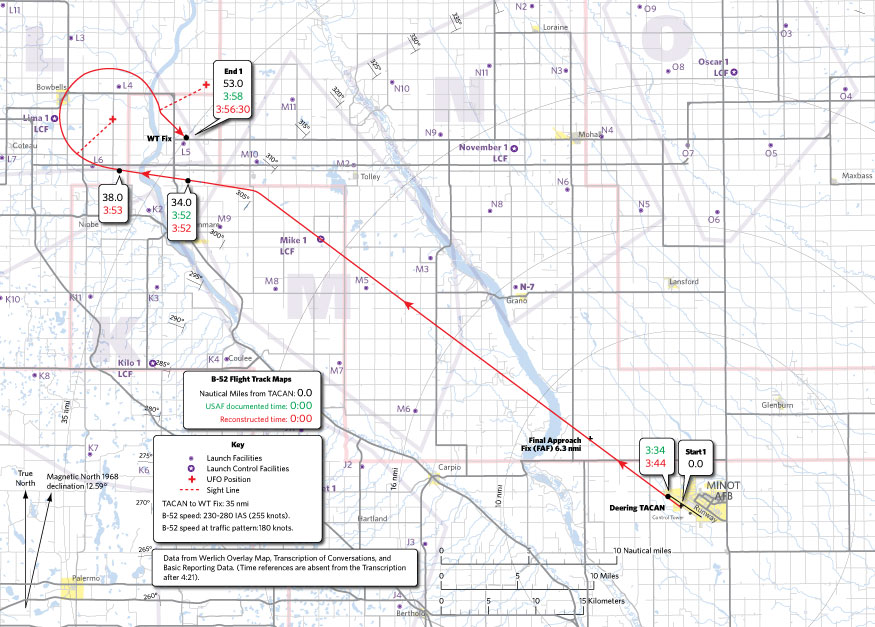
At 3:52, RAPCON informed the pilots, “the UFO is being
picked up by weathers [sic] radar also,
should be your 1:00 position 3 miles now.” About a minute later, McCaslin
observed the UFO on the B-52 radarscope off the right wing at co-altitude. As
the B-52 banked around the wide turn, the UFO maintained its distance, while
transiting 6 miles to the northeast outside of the B-52 turn radius, to a
position 3 miles off the left wing after the turnaround.
Following the turnaround, the UFO began pacing the
B-52 until the aircraft reached the WT fix to begin the descent back to the
base. At this point, within a 3-second sweep of the radarscope, the UFO
appeared to instantaneously close distance to one mile on the aircraft at what
would be an extremely high-rate of speed, while altering course to match the
heading, speed, and descent of the B-52.[102]
Werlich’s original report to Blue Book included
estimates of the closure speed, and acknowledges a right to left (of the aircraft)
passage of the UFO, though the sequence is transposed:
Initially the target traveled approximately 2½ mile in 3 sec or at about 3,000 mi/hr. After passing from the right to the left of the plane it assumed a position off the left wing of the 52.[103]
On the other hand, in the
official report, he omits the UFO passing from right to left of the B-52, and
simply notes after the turnaround, “A
BRIGHT ECHO SUDDENLY APPEARED 3 MILES ABEAM AND TO THE LEFT OF THE AIRCRAFT.”
Moreover, he does not provide specific data or estimates of the closure rate,
other than stating, “THE ECHO RAPIDLY CLOSED ON THE AIRCRAFT.”
[2] AFTER ROLLING OUT OF A RIGHT TURNAROUND TO THE TACAN INITIAL APPROACH FIX, A BRIGHT ECHO SUDDENLY APPEARED 3 MILES ABEAM AND TO THE LEFT OF THE AIRCRAFT. THE ECHO RAPIDLY CLOSED ON THE AIRCRAFT AND REMAINED AT ABOUT 1 MILE.[104]
Although Werlich remains oblivious to the weather
radar detection of the UFO, he nevertheless provides the exact location of the
B-52 at the time of the initial air-radar observation at “38 NAUTICAL MILES NW
300 DEGREES RADIAL.”[105]
He indicates the same location on his Overlay Map, including the initial
position of the UFO three miles to the right of the B-52, and the secondary
position of the UFO six miles northeast of the original position (three miles
to the left of the B-52 after the turnaround).

Partial scan of Werlich’s Overlay Map showing the B-52
flight track and 180-degree turnaround back over the WT fix (black circle). The
UFO positions (X’s) and flight track are in red, while the blue section is
Werlich’s estimate of where the radarscope photos were exposed. Werlich also
indicated six lat./long. coordinates on the Overlay to accurately align it onto
a base map. Click for complete Overlay Map.
On Thursday, 31 October, in responding to Marano’s
earlier request for information on other radar systems, Werlich insisted the
only radar system that detected a UFO was onboard the B-52.
Anyway, I’m sending the RAPCON TAPES, PHOTOS, and an overlay showing a movement of the aircraft, description of the aircraft movement prior to VFR [Visual Flight Rules].[106] Aircraft was going through maneuvers and it would be almost impossible to track it perfectly cause he was doing steep turns, “S” turns, etc. Now time and duration of the sighting was in my message. Speed of the B-52 was in the TWX. I only stated one radar in the message because there was only one radar set. The [B-52’s] ECM [Electronic Counter Measures] equipment hadn’t been used. RAPCON was painting, IFF [Identification Friend or Foe] equipment was operating in the airplane. It’s a fairly good size blip. Every time it sweeps it shows the blip. The object would have been covered by the blip. There is a Sage site to the south [Minot AFS]. They do not remember having any unidentified paints. The only one I have is the one on the plane.[107]
Even after Werlich sent Blue Book “the RAPCON TAPES”
confirming the weather radar detection of a UFO correlated with the B-52, in
the weeks following he did not respond to requests from Marano for additional
information regarding the weather radar.[108]
Werlich also said he would send Blue Book an “overlay showing a movement of the
aircraft.” Later in the conversation, he informed Marano that the overlay was
based on a classified 200-series bomb-targeting map chart, and due to security
restrictions he was sending an overlay to save time, while directing Blue Book
to acquire the classified master chart at Wright-Patterson AFB. He then told
Marano:
Gen Hollingsworth has been given all the information that Col Werlich obtained. Col Werlich said that Gen Hollingsworth was briefing Gen Compton and this briefing was probably going on at the time that Col Werlich was speaking with Lt Marano (time was approx 2 pm, EST, [Thursday] 31 Oct).[109]
The impression is that Werlich prepared the original
map at the behest of Hollingsworth for briefing SAC Commanders. Following
receipt of the Basic Reporting Data, if Blue Book had not specifically
requested the supplemental information it seems unlikely that Werlich would
have forwarded any of the supporting documentation.
B-52 Loss of Radio Transmission
At 3:58, as the B-52 cleared the WT fix, within one
sweep of the radarscope the UFO appeared to instantly close distance on the
aircraft. At the same time, the B-52 radio transmitters failed. When the UFO
departed and communications resumed after 4:02, RAPCON queried Capt. Runyon
wondering “if that could have been your radio troubles,” to which he responded,
“I don’t know, but that’s exactly when they started.”[110]
According to Werlich, when the echo rapidly closed to
one mile:
[2] AT THIS MOMENT THE UHF TRANSMISSION FROM THE B-52 TO RAPCON WAS INTERRUPTED IN MID-SENTENCE. THE RADAR ECHO CONTINUED WITH THE AIRCRAFT DURING ITS TACAN PENETRATION FOR ABOUT 20 MILES. RAPCON HAD REQUESTED THE AIRCRAFT TO CHANGE UHF FREQUENCIES TWICE BUT THE AIRCRAFT WAS UNABLE TO TRANSMIT ON EITHER FREQUENCY. THE B-52 UHF RECEIVER WAS NOT AFFECTED NOR WAS THE IFF/SIF IDENTIFICATION FEATURE AFFECTED. DURING THIS TIME, RADAR SCOPE PHOTOS WERE OBTAINED AND CLEARLY SHOW THE RADAR ECHO. AS SOON AS THE ECHO DISAPPEARED THE B-52 UHF TRANSMITTER BECAME OPERATIONAL.[111]
Werlich stated that “RAPCON REQUESTED THE AIRCRAFT
CHANGE UHF FREQUENCIES TWICE BUT WAS UNABLE TO TRANSMIT ON EITHER FREQUENCY.”
According to the communications transcript, at 4:00, RAPCON requested the B-52
“attempt contact on frequency 271.3” without response, until 4:02 — after the UFO
had disappeared from the radarscope — when they were asked to change to 326.2 and
heard loud and clear.[112]
On Thursday, referring to the fact that the B-52 had two separate UHF radios
onboard; Werlich explained to Marano that the crew changed both radios with no difference in functioning, which
discounts the possibility of equipment malfunction.[113]
The unusual part is the B-52 was in the middle of a sentence and the voice just quit transmitting right in the middle of the word. Because we had an accident a couple of weeks ago we were quite interested. Ground control asked them if they had any trouble to give Mayday Squawk. The airplane changed both UHF and neither would transmit but they could receive, and each time to show that they could receive they hit the ident squawk which would last for thirty seconds each time. There was quite a bit of this. The navigator [saw] the paint disappear as fast as it appeared. My personal opinion is that it couldn’t be a malfunction because they transmitted before and afterwards. The aircraft was not checked out afterwards because the transmission was working. I didn’t know if the heavy haze would have been enough to blank out the transmission.[114]
Later in his comment
section, Werlich listed the radar echo and loss of transmission as two of the
(6) FOUR OCCURRENCES THAT CANNOT BE CORRELATED OR EXPLAINED AT THIS LEVEL ARE: (A) WHAT CAUSED THE AIRCRAFT RADAR ECHO. (B) AIRCRAFT LOSS OF UHF TRANSMISSION.[115]
Certainly there is a correlation between the close approach of the UFO
and the UHF transmission failure. Later, during the B-52’s overflight of the
UFO on or near the ground, Runyon recalled that the radio transmitters failed
again.[116] In both instances, none of
the B-52’s other electronic equipment was affected, nor the radio reception and ability of the SIF/IFF transponders to transmit.[117]
The B-52 continued on its descent to Minot AFB. At
4:02, after the UFO had disappeared from the radarscope and radio
communications fully resumed, the aircraft was about 19 nautical miles from the
runway emerging below the overcast at 9,000 feet MSL. These estimates are based
on our reconstruction of the B-52’s flight track, supported by Dr. Claude Poher’s
photogrammetric study of terrain features evident in B-52 radarscope photograph
#783, which reveal a section of Lake Darling on the periphery of the scope.[118]

Radarscope Photo #783 with the extreme positions of
the B-52 during the radarscope photos. Photo 783 has been rotated to the
true course of the B-52 at 122 degrees, and scaled to match the
underlying USGS map, Werlich Overlay Map, and satellite image of Lake
Darling. The ground features on the periphery of the scope at 70-80
degrees appear to correspond to Lake Darling. No UFO echo is evident in
#783. The B-52 covered 2.65 nmi over the course of the photos, and was
18.8 nmi from the TACAN at the most probable altitude of 8865 feet MSL
during 783. A satellite image of Lake Darling at the Grano Crossing is
available from Wikimapia.
Werlich estimates the B-52 was closer to base at the
time of the last radarscope photo:
RADAR ECHO ACCOMPANIED AIRCRAFT TO APPROXIMATELY 14 NAUTICAL MILES, 296 RADIAL, APPROXIMATELY 9,000 FEET MSL.[119]
[2] WHATEVER CAUSED THE ECHO WAS NOT VISUALLY SIGHTED BY THE AIRCRAFT CREW MEMBERS NOR WAS IT SEEN BY THE TOWER OPERATOR WHO WAS FOLLOWING THE AIRCRAFT PROGRESS THROUGH BINOCULARS. DUE TO HEAVY HAZE AND SEVERAL CLOUD LAYERS, THE AIRCRAFT WAS NOT VISIBLE THROUGHOUT THE APPROACH.[120]
Again, Werlich ignores information in the AF-117s.
In fact, the Base Operations dispatcher directed the ground observers at N-7 to
the precise time and location of the incoming B-52 in the west. At 4:02, the
UFO had disappeared from the radarscope as the B-52 emerged below the overcast
at 9,000 feet. The ground observers were completely unaware of the B-52’s
air-radar UFO encounter and loss of radio transmission, while under the
impression that the aircraft had been diverted to check out their UFO
observation in the southeast. For example, O’Connor noted, “a B-52 was sent to
the area to check out the sighting and was seen west of the object at first.”[121]
Security Alert Team member A1C Jablonski compared the bright illumination of
the UFO to the landing lights of the incoming B-52:
When the B-52 had flown in its search, it had been using its landing lights which were quite similar in nature. As to avoid confusion between the plane and the object, Base Ops had pointed out where and when we saw the B-52. Must add that the B-52’s engines could be easily heard, while the UFO made no sounds to be heard at about the same distance.[122]
For over an hour, the
observers at N-7 had been reporting a UFO in the southeast, but by the time the
B-52 appeared high in the west, the UFO had gradually descended to the horizon
and was no longer seen in the area.[123]
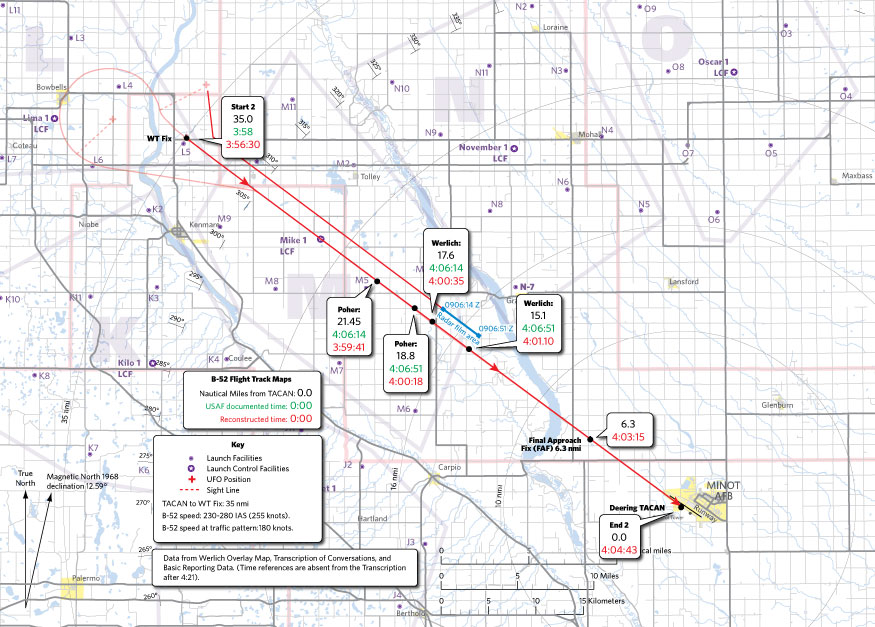
Clearing the WT fix, the UFO closed to one mile and the
B-52 radio transmission failed. According to the transcription, communications
fully resumed at 4:02, after the UFO had disappeared from the radarscope. The
observers at N-7 were directed to the time and location of the incoming B-52
and would have first observed the aircraft as it emerged below the overcast at
9,000 feet. According to Poher, at the time of the last radarscope photo
(4:00:18 by our reconstructed time), the B-52 would have appeared in the
west-southwest at about 6.5 miles from N-7, at an altitude of 8865 feet. At the
same time, the UFO they had been observing in the southeast disappeared from
view. It is notable that the UFO pacing the B-52 disappeared from the
radarscope shortly before emerging below the overcast into view. In addition, our
reconstructed time during this segment is about 1 minute and 30 seconds behind
the documented time; perhaps because the B-52 speed during the turnaround back
over the WT fix was less than our average of 255 knots.
After the B-52 passed by on its way to the base, the observers at N-7
returned to their respective duties. O’Connor and Isley eventually
completed their maintenance work at N-7, secured the site and returned
to base. Jablonski and Adams went on patrol, while remaining in radio
contact with the Base Operations dispatcher.[124]
Along with SSgt. Bond, they continued reporting a UFO in the west until
well after the B-52 terminally landed at 4:40. According to Jablonski:
Prior to our return to N-1 it caught our attention again, this time WSW in location. It had appeared as before starting bright orange-red, to white and finally green. The object was stationary at the time and appeared aprox. 1,000 FT above ground. The green light started to diminish slowly [until] no longer seen.[125]
B-52 Air-visual Observation
The B-52 continued on descent to Minot AFB.
According to the communications transcript, after 4:04, RAPCON cleared the B-52
for “low approach report missed approach” to the runway. Following this,
procedures required RAPCON to direct the B-52 onto the radar traffic pattern,
which would ultimately bring them back around to final approach. By 4:06, they
had passed the runway and were turning left on the 335-degree crosswind leg of
the traffic pattern, at a standard altitude of 3200 feet MSL (more or less
1,500 feet above the ground). After 4:09, RAPCON advised the pilots that if
radio transmissions fail while in the traffic pattern they were cleared to take
over visually; then vectored the B-52 to turn left to a heading of 290 degrees
onto the downwind leg. After a few minutes, this would bring them out in the
vicinity of N-7. At 4:13, RAPCON queried Runyon whether they were “observing
any more UFOs,” to which he responded, “Negative on radar, we can’t see
anything visually.” The controller affirmed, “The personnel from the missile
site advise they don’t see anything anymore either.”[126] RAPCON then provided the remaining
vectors directing the B-52 to final approach at 4:17.
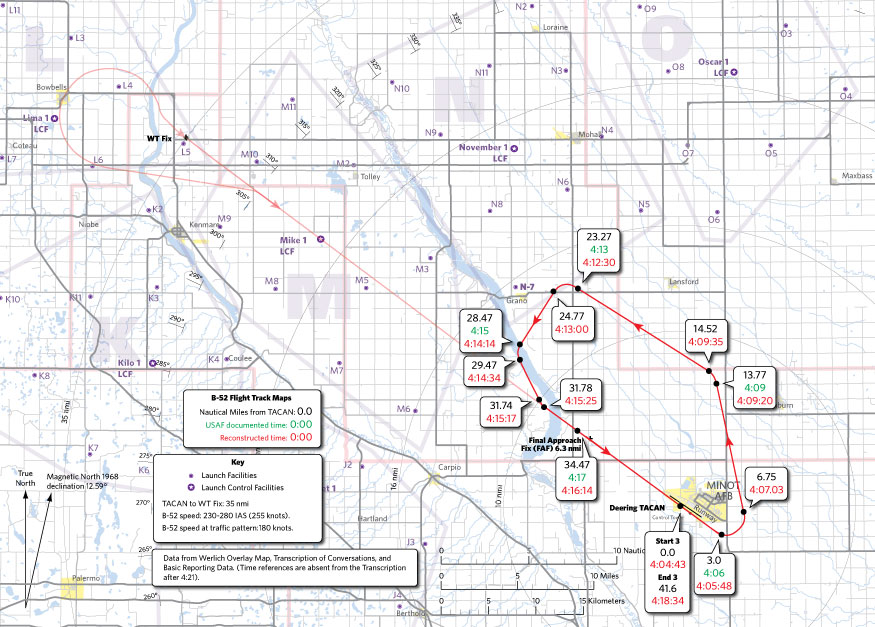
First go-around of the traffic pattern after a low approach
and missed approach to the runway. After 4:06, the B-52 is turning onto the
335-degree crosswind leg. [Note: 4:06:14-4:06:51 is also the time recorded on
the radarscope photos, suggesting that the B-52 onboard time was ahead by 6-7
minutes.] At 4:13, RAPCON asks the pilots whether they are “observing any more
UFOs,” before providing the vector for the turn onto the 200-degree base leg.
Total flight time is 13:51 minutes.
According to B-52 crewmembers, some time after radio
communications resumed the pilots received an unexpected request from a General
officer to continue back around the traffic pattern and overfly a UFO on or
near the ground.[127]
Runyon reluctantly agreed, and rather than landing, at 4:21, requested another
“vector around for an IFR, surveillance approach” with a terminal landing or
“full stop” at 4:40.[128]
RAPCON confirmed, then directed the B-52 to once again “turn left heading 335
maintain 3200” onto the crosswind leg; reminding them that if the radios fail
they are cleared to take over visually and land. After this, the remainder of
the time code references, including RAPCON’s next vector for the 290-degree
downwind leg (when the pilots observe the UFO ahead of the aircraft for several
minutes before turning over it), are conspicuously absent from the
communications transcript.[129]
At some point, RAPCON informed the pilots, “JAG 31 (garbled) requests that
somebody from your aircraft stop in at baseops [Base Operations] after you
land,” then provided the 200-degree vector to the base leg, 140-degree dogleg,
and finally, a 115-degree vector to an “extended final” approach.[130]
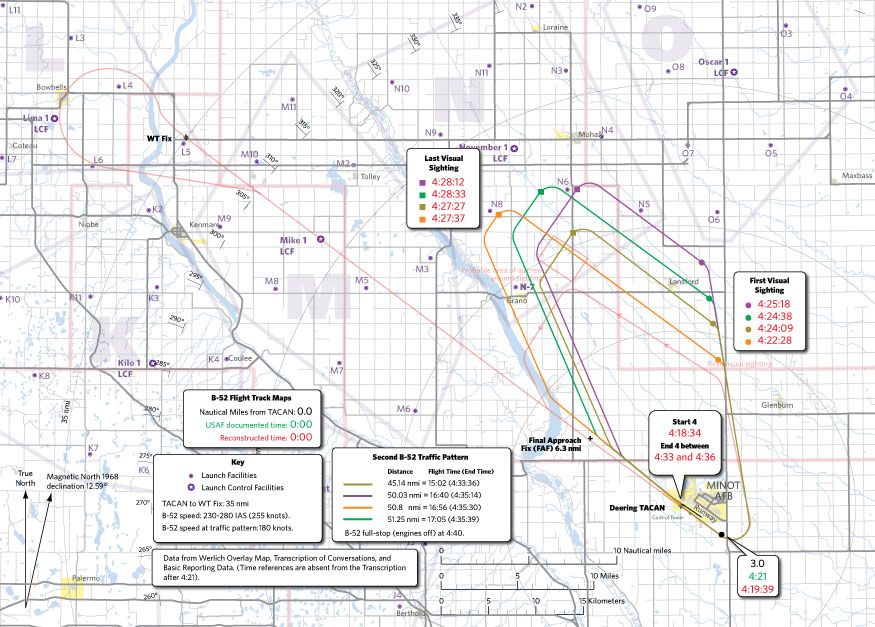
Second circuit of the traffic pattern. Since time
references are omitted from the transcription following 4:21, we have plotted
several possible patterns that would bring the B-52 to a full stop with engines
off at 4:40. Total flight time is between 15:02 and 17:05 minutes, which is an
additional 1-3 minutes compared to the first go-around, indicating that the
B-52 flew further out (to the north and/or west) during the second go-around.
The communications transcript reads as if both
circuits around the traffic pattern were merely routine and uneventful.[131]
In fact, during the second go-around, as the B-52 was turning onto the
290-degree downwind leg, pilot Major James Partin observed a
bright orange ball of light at my one o’clock position. It appeared to be about 15 miles away and either on the ground or just slightly above the ground. The light remained stationary as we flew toward it. I turned onto the base leg about one mile to the South of the light and was above it. The light did not move during this time.
He noted the location of the
initial observation as 10 miles northeast of Minot AFB, and the time of the
air-visual observation as 4:30-4:35.[132]
According to co-pilot Capt. Bradford Runyon:
RUNYON: Just as soon as we rolled out at wings level [on the downwind leg] there was an orange glow sitting out there, almost off our nose about 11:30 position, a little bit to the left side of the airplane, so we were heading straight to it.
Runyon got busy completing
the routine checklists in preparation for landing, but when he eventually
looked up and out the pilot’s window they were flying alongside a very large
UFO.
RUNYON: We are level and don’t bank until we get right to the end of it. Major Partin started his turn as we got abreast of the end and turned almost over the top of the thing. I am sure we were told to turn by the ground controllers so they knew exactly where we were in relation to it.[133]
During the second go-around, Runyon recalls that
RAPCON provided the vectors to fly directly to the location, and turn onto the
base leg around and over the top of the UFO. On the other hand, Partin simply
notes in his AF-117, “I turned onto the base leg about one mile to the South of
the light and was above it.” Werlich locates the B-52 at the 200-degree turn
onto the base leg of the traffic pattern for the first go-around:
“POSITION OF AIRCRAFT DURING VISUAL SIGHTING: 14 NAUTICAL MILES 320
RADIAL OF THE DEERING TACAN AT 3200 FEET MSL.”[134]
He also indicates the location of the UFO within a rectangle representing the
“probable area of aircrew ground sighting” two miles further out on his Overlay
Map.
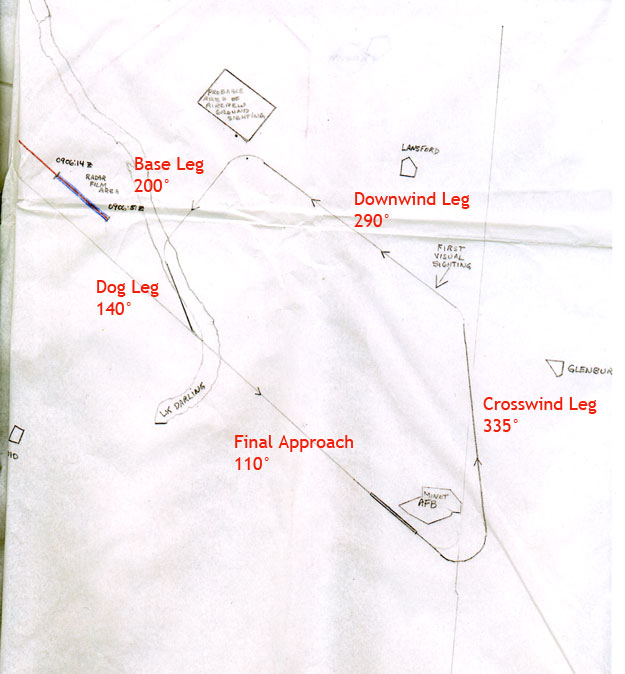
Partial scan of Werlich’s Overlay Map showing the first
circuit around the traffic pattern. Werlich did not plot the second circuit,
when the pilots observed and overflew the UFO on or near the ground.
Werlich did not interview the B-52 crewmembers, and
it seems he did not personally interview Partin before completing the Basic
Reporting Data. His brief account is at variance with several details compared
to Partin’s AF-117 questionnaire, which was completed two days after submitting
the Basic Reporting Data. For example:
[2] REMAINING AT RADAR TRAFFIC PATTERN (3200 FEET MSL) THE AIRCRAFT COMPLETED ONE GCA [Ground Controlled Approach] AND MISSED APPROACH AND WAS ON A HEADING OF 335 DEGREES [“As I turned on to the (290-degree) downwind leg … I saw a bright orange ball of light.”] FOR A RADAR VECTOR TO THE GCA DOWNWIN[D] LEG WHEN THE INSTRUCTOR PILOT, SITTING IN THE RIGHT SEAT [Partin was piloting from the left seat] VISUALLY SIGHTED AN OBJECT AHEAD AND BELOW. AS THE AIRCRAFT APPROACHED TO WITHIN APPROXIMATELY 2 MILES [“I turned about one mile to the South of the light and was above it.”], THE OBJECT SEEMED TO REMAIN STATIONARY AND CLOSE TO THE GROUND. VISIBILITY WAS REPORTED AS 25 MILES AT THAT ALTITUDE. THE AIRCRAFT TURNED ONTO THE BASE LEG, LOST SIGHT OF THE OBJECT AND CONTINUED WITH A GCA AND TERMINAL LANDING.[135]

Maj. Partin’s drawing of the UFO in his AF-117 Questionnaire (p. 6). In a 2001 interview, he recounted that at
1500-1700 feet altitude a house on the ground appeared to be about the size of
a die, or a Monopoly house, and the UFO appeared to be much larger than that. The
second drawing (bottom) represents the head of a match at arm’s length overlaid
on the orange ball of light. The match head is about 1/4 the diameter of the
ball of light, and the object is about 100 arc minutes. Partin states that he
turned "one mile to the south of the light and was above it" (4),
whereas, Werlich states approximately 2 miles to the south (BRD, 7). At 1-2
miles, the object would be about 150-300 feet in diameter.
Werlich’s description of the UFO also varies from
Partin’s account:
WHEN VIEWED FROM ABOVE BY A B-52 CREW, THE OBJECT [HAD A] FAINTLY WHITE OBLONG HALO ON ONE SIDE WITH AN ORANGE SPOT ON THE OTHER SIDE AND THE BODY APPEARED TO BE A BRIGHT WHITE LIGHT.[136]
Partin did not describe “AN
ORANGE SPOT,” or the body appearing “TO BE A BRIGHT WHITE LIGHT” in his AF-117.
Rather, he described it twice as a “bright orange ball of light,” which
compared to a common object looked “like a miniature sun placed on the ground
below the aircraft.” These differences suggest that Werlich received a second
hand account of Partin’s observation, most likely from Base Commander Col.
Kirchoff, subsequent to Partin’s debriefing in Base Operations after landing.
Our 2001 interview with Partin
provided some additional details, including his recall of the air-radar
encounter that was not mentioned in his AF-117.
PARTIN: I recall we were on a crew mission and we were back in the local area at Minot, and we were about ready to make our penetration and low approach, and I guess we were in the neighborhood of 20,000 feet probably. The radar called and said he had a return off the left wing and did I see anything? I looked up there and did not see anything. All of a sudden, he said “God Almighty!” and I said, “What’s wrong?” He was alarmed, you know, he said that whatever that was took off to our left at a tremendous rate of speed, he couldn’t even measure it.
INTERVIEWER: Is he seeing this on the radarscope?
PARTIN: Yeah, he watched it go. So we forgot it and went on down and were shooting low approaches in the traffic pattern. Somewhere in the process, I changed seats, got into the co-pilot’s seat. I don’t remember doing that — but I remember looking off to my right probably about the 2 o’clock position, as they used to say, and low and I saw a — it was sort of oblong, there were, looked like windows around it that were lit and it was just hovering there… . We must have been around 1500-1700 feet above the ground — you could see houses on the ground from that altitude, and they looked like, you know, the size of dice — a die.
INTERVIEWER: Maybe like a Monopoly house?
PARTIN: Yeah, right, and this was much larger than that… . When I described to the crew over the interphone what I was seeing the navigator, the radar navigator, and everybody tried to get up in our lap in the cockpit and — [laughs]. [137]
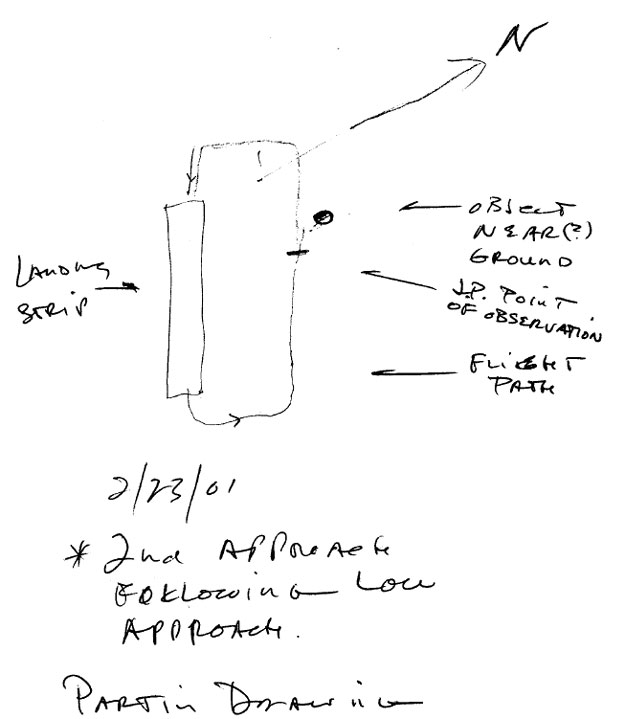
Maj. Partin’s drawing made during our meeting in February
2001. The notations are mine based on information provided by Partin. In his
AF-117, he noted it was an “unusually bright light I had never seen at night in
this area,” which “appeared to be about 15 miles away” and either on or
slightly above the ground. It disappeared from view when he “turned onto the
base leg about one mile to the South of the light and was above it” (4, 5).
Whereas, Capt. Runyon recalls that the UFO was a little to the left of the
B-52, inside the turn radius, and they flew alongside before turning over and
around the UFO onto the base leg of the traffic pattern.
While Partin’s preoccupation was piloting the B-52
at low altitude, Runyon would have been in a better situation to view the UFO.
In a 2000 interview, you get the impression from Runyon’s descriptions that he
is struggling to make sense of what he is seeing, over too brief a time.
RUNYON: We were vectored back around over the thing and on our downwind leg, or base leg, then perpendicular to the runway, we were just to the outside of it, so Major Partin could look right down into — over the object. I was in the right seat so I had to look sort of across the airplane. Well, anyway our radios went out again, of course every time the radios went out, you know, they thought we had a problem… . Anyway we’re looking and surrounded by the airplane too, close to the ground things go by real fast so I didn’t have a long time to look at the object, but I could see the part that was — everyone said it was glowing, but anyway, there was pretty much an egg-shaped object on the ground, okay? It was lined up with the runway, but the orange glowing part, which looked like either molten metal, or lava, something like that — it wasn’t shiny or glowing. I mean it was just, well, it was dull… . But the one part that sort of made me wonder whether the thing had turned around, or why it was pointed in the direction it was, then there was a shiny tubular section that came from the end, away from the runway, it was a smooth metallic-looking round tunnel. It attached to a sort of crescent moon-shaped object, which sort of wrapped around the one end of the larger mass, and it was smooth, shiny, metallic-looking, and —
INTERVIEWER: Like a bumper?
RUNYON: Yeah, only bigger, it was a pretty good size too.
INTERVIEWER: The bumper was separated from the object?
RUNYON: Yes, by this tunnel-like thing. But, where the object was curved on the back end — or the front end, whichever it was — the metallic part also had the same curvature, and it was the same width as the rest of it, but just wasn’t very long. I tried looking in there. I could see some lights, and it seems to me I can remember green and yellow. There were lights, and I thought I should be able to see objects in there. We went over real fast and I really couldn’t distinguish anything inside.[138]

Capt. Bradford Runyon’s drawing of the UFO following our
initial interview. He cautiously estimated the size as 200 ft in length; 100 ft
in width; and 50 ft. in height. At 3200 MSL, their altitude would have been
around 1500 feet above the local terrain.
Based on discussions overheard from the flight deck,
the impression of B-52 navigator Capt. Patrick McCaslin was that they flew
directly over the UFO.[139]
McCASLIN: The first time I was aware that the pilots saw anything was after that low approach, when we came back and were basically bombing the position, and when they — there was an expletive from the top, they started describing this thing and asking if I wanted to come up and see it. After the fact, when we were talking in the debriefing, and as we were taxiing in and all that, everybody agreed it was pretty spectacular.
INTERVIEWER: Did he describe it to you?
McCASLIN: I don't remember if it was Brad or one of the other pilots. The description to me was this: that it was an elliptical shape, kind of a cough drop-shaped thing, glowing orange with a boomerang exhaust, or boomerang-shaped exhaust, or whatever — a fluorescence off one end the same color. And that’s all I remember of the description.[140]
Werlich listed the
air-visual as the third of
(6) FOUR OCCURRENCES THAT CANNOT BE CORRELATED OR EXPLAINED AT THIS LEVEL ARE: … (C) THE CAUSE OR SOURCE OF VISUAL AIRCRAFT SIGHTING OF A BRIGHTLY LIGHTED OBJECT AS PREVIOUSLY DESCRIBED IN PARAGRAPH A(6) AND A SIMULTANEOUS GROUND SIGHTING IN APPROXIMATELY THE SAME LOCATION.[141]
Werlich
is under the impression that ground personnel observed the B-52 overflight of
the UFO.[142] In his
original report to Blue Book on 24 October, he noted the location of the UFO
“about 10 miles northwest of the base,” which is the location of the bright UFO
“moving in a large circular area to the south” of N-7 reported by O’Connor and
Isley at 3:00, until disappearing around 4:02. Werlich assumes the UFO observed
by personnel at N-7 was the same UFO later
observed during the air-visual observation and overflight by the B-52
pilots. For example,
In response to the maintenance man’s call the B-52, which had continued its penetration run, was vectored toward the visual which was about 10 miles northwest of the base. The B-52 confirmed having sighted a bright light of some type that appeared to be hovering just over or on the ground.[143]
Early on Monday, 28 October, O’Connor and Isley met
with Werlich to complete the AF-117 questionnaires. At this time, Werlich
queried the maintenance team whether they did in fact observe the B-52 in close
proximity to the UFO on the ground. Later, during his conversation with Marano
on Thursday, he explained,
I (Col W) asked if they saw the B-52 come towards the object. We know the B-52 got real close to it. Did they see the object on the ground? (Lt M asked). They were able to see a light source while the 52 got in real close then it disappeared.
It seems that Werlich continues to confuse two
distinct incidents separated in time. In fact, the ground observers at N-7 were
completely unaware of the B-52’s close overflight of the UFO on or near the
ground, which occurred about 26 minutes after their final observation. Nobody reported a UFO in this location, and even
the Base Operations Dispatcher was not privy to RAPCON communications during
the second go-around, and unaware of the air-visual observation by the pilots.[144]
Col Werlich said Lt Marano should get a section map of the area… . Look on map, half way down the runway, TACAN, 320 radius, 16 nautical miles. This is where aircraft saw the object. There’s farm fields there. There is nothing there that would produce this type of light. The same for O’Connor and [Isley] from November 7 which is near Grano. I have gone over that [area] with a chopper… . I (Col Werlich) think you will find that the most information comes from Airman O’Connor and Isley, and an aircraft instructor [Partin]. Much of their description and discussion incorporates the activity of the B-52. It was only at the end that I was unable [able?] to pin point the fact that they did observe a light source and the B-52. You can see the lights of the base for at least 50 miles away. I (Col W) asked if they saw the B-52 come towards the object. We know the 52 got real close to it. Did they see the object on the ground? (Lt M asked). They were able to see a light source while the 52 got in real close then it disappeared.[145]
Werlich is referring to the B-52 pilot’s air-visual
observation of the UFO (at about 4:28), whereas, during questioning O’Connor
and Isley were undoubtedly referring to their final observation of the UFO (at about 4:02), when the B-52 first
appeared high in the west. At the time, all of the observers at N-7 were under
the impression that the B-52 had been diverted to the area to check out their
UFO sighting. In either case, they would have seen the B-52 “come
towards the object.” They did “see
the object on the ground,” low on the
horizon in the southeast when it disappeared, and “they were able to
see a light source while the B-52 got in real close,” as the aircraft also disappeared low in the southeast on its way to
base.
In any case, these discrepancies underscore the lack
of resources available for Blue Book investigators to collect and collate all
of the available data, and methodically evaluate the information.
Oscar-7 Break-in Investigation
Shortly after the B-52 landed, security alarms at
the O-7 missile Launch Facility sounded in the Oscar-Launch Control Center.[146] It was highly unusual for both the Inner-zone
and Outer-zone alarms to activate simultaneously, and in this instance, Oscar-Flight
Security Controller SSgt. William Smith personally accompanied his Security
Alert Team of A1C Donald Bajgiar and A1C Vennedall to secure the site.[147]
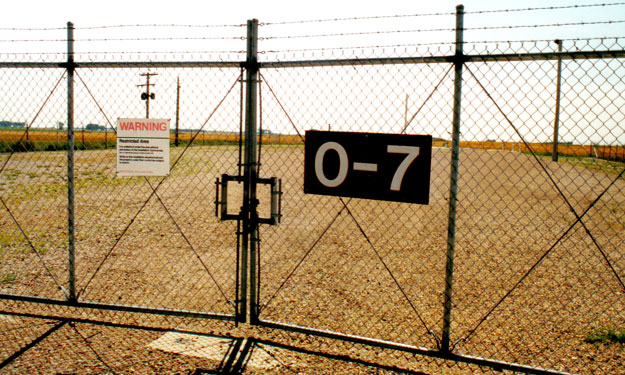
Oscar-7 Launch Facility located 24 miles north of Minot AFB
to the south of ND Highway 5. By coincidence, at around 5:00 a.m., the
maintenance team of O’Connor and Isley were driving by on their return to base,
at the same time the Oscar-Security Alert Team was arriving to investigate the
break-in.
Col. Werlich’s third comment in the Basic Reporting
Data pertains to the missile silo break-in.
(3) AT 0949 ZULU (0449CDT) OSCAR 7 SITE’S INNER AND OUTER ALARMS SOUNDED AT WING SECURITY CONTROL. OSCAR 7 IS 10 MILES NORTH AND ELEVEN AND ONE HALF MILES EAST OF NOVEMBER 7. A SECURITY ALERT TEAM WAS DISPATCHED AND FOUND THE PADLOCK TO THE CHAINLINK FENCE OPEN AND THE FENCE GATE STANDING OPEN. THIS SET OFF THE OUTER ALARM. INSIDE THE COMPLEX, A HORIZONTAL DOOR HAD BEEN UNSECURED AND LEFT OPEN AND THE COMBINATION LOCK DIAL HAD BEEN TURNED OFF ITS SETTING THUS TRIGGERING THE INNER ALARM. NO TRACKS, PRINTS, OR IMPRESSIONS WERE FOUND.[148]
He listed this as the fourth
of
(6) FOUR OCCURRENCES THAT CANNOT BE CORRELATED OR EXPLAINED AT THIS LEVEL ARE: … (D) THE OSCAR 7 ALARMS COULD BE ATTRIBUTED TO CIRCUMSTANTIAL EFFORT OF PRANKSTERS, HOWEVER NO EVIDENCE OF TRESPASSERS WAS FOUND.[149]
An attempt to break into an ICBM missile silo is
obviously a serious security concern, though to achieve this required passing
through formidable barriers. The 150 Launch Facilities at Minot are dispersed
over a wide area to limit an attack from destroying more than a handful. Each
of the 15 Launch Control Centers are responsible for 10 Minuteman missiles,
while aboveground Launch Control Facilities constantly monitor missile security
status.

The weather cover has been opened and the vault door
removed (lower right), providing access to controls for raising the large
primary door, or A-plug. (Photo: USAF, Western Launch and Test Range,
Vandenberg AFB, CA).
Surrounding each Launch Facility is a chain-link
fence, with a chain and padlocked entry gate, and onsite motion detectors that
trigger the outer-zone perimeter alarms. Additional systems prevent
unauthorized access to the missile and nuclear warhead. The underground missile
silos and support facilities are hardened in concrete and steel, while access
is protected by inner-zone alarm systems linked to the respective Launch
Control Center, while also networked to the 91st Strategic Missile
Wing, Security Control, and SAC headquarters.[150]
In order to access the missile silo and auxiliary
equipment rooms required personnel to unsecure a weather cover (navy-style
hatch) and enter a combination, which allows for the extraction of the vault
door.
This provides the ability to retract the locking bolts, and operate the
hydraulic controls that slowly raise the massive steel and concrete primary
door (A-plug, or personnel access hatch), allowing access into
the shaft. They would
then descend a few feet down the shaft and enter another combination into the
secondary door, or B-plug, allowing the retraction of several locking pins. The
solid steel B-plug, weighing several tons, is suspended in the
passageway on a large threaded rod from the lower level of the equipment room. Activating a switch, the
plug requires at least 10 minutes to lower far enough for any human to enter
the equipment rooms
adjacent to the missile silo, while also allowing sufficient time
for a Security Alert Team to arrive on site.
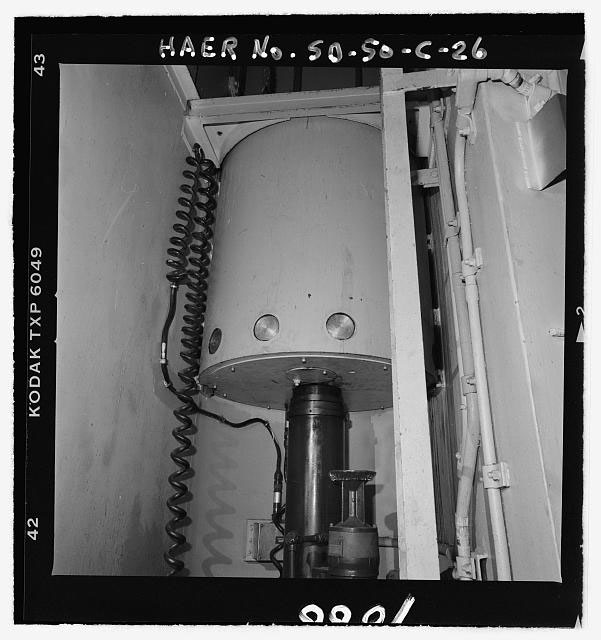
The B-plug in the fully retracted position, allowing access
to the upper and lower launch equipment rooms surrounding the missile. (Photo:
Library of Congress). In addition, see Bruce Ecker’s spherical panoramic
photographs of Minuteman Launch Facilities at Ellsworth AFB, SD, from: The Minuteman Missile National Historic Site.
In the case of O-7, the gate had been unpadlocked
and left standing open. Physical entry onto the site triggered the OZ alarm. In
addition, the weather cover was unsecured and left propped open. Inside,
someone had turned the combination dial on the vault door off of its setting,
thus triggering the IZ alarm.
The unit history of the 91st Strategic
Missile Wing for the fourth quarter of 1968 records security alarm violations
for the 150 Launch Facilities at Minot AFB. For example, in October there were
17 IZ alarms and 387 OZ alarms. The OZ alarms decreased in October due to a
decline in animal activity, but increased overall during the quarter due to accumulations
of snow. The unit history also notes an ongoing problem with defective OZ
transmitters, particularly their tungsten filaments, which frequently failed
due to extreme weather conditions and age. There are no indications of any
physical violations of the sites, or the 24 October O-7 break-in.[151]
Though Werlich suggested that this might have been
the result of “pranksters,” he seemed less convinced during his final
conversation with Marano. The timing of the break-in is quite curious with
everything else that was going on, and it is hard to imagine that this
violation would not be considered a serious offense.

Security Alert Team at a Launch Facility checking the
vault door, which houses the controls for raising the missile silo's
Personnel Access Hatch, and (inset) the Flight Security Controller
monitoring missile security status at the Launch Control Facility (Photo: USAF).
This is a sensitive subject. Anybody that could unlock the padlock wouldn’t be a prankster from the farm areas. There are keys for these padlocks and it’s hard to judge how many keys have been made. It looks like a navy hatch and underneath is the combination lock. Pranksters just couldn’t go and open it. The person, if it was a person, would have to know how to open it. We have had about three occurrences of this in the last two or three years doing this. All three of these cases were traced back to AP’s. Guys who had been in the service on these areas. It is not a serious offence. 99 chances out of 100, that if a person, a human being, accomplished this thing then it had to be somebody who had a key to the padlock. Lt Marano told Col Werlich that we have no evidence though that the UFO events did this. Col Werlich agreed but said that a Lieutenant examined the area the next day and could find no evidence of cars, tire tracks, footprints, etc. Col Werlich said he didn’t know if an examination [sic] investigation was going on or not but felt they probably were looking into it. Lt Marano asked him to get the results of their investigation.[152]
No further information was
provided to Blue Book investigators.
Reports of Two UFOs
Werlich’s fourth comment refers to two similar
objects observed concurrently by at least 14 ground observers from various
locations, including the security personnel at Mike Flight, Juliet Flight, and
Oscar Flight. Werlich simply notes:
(4) AT ONE POINT DURING THE GROUND SIGHTINGS, THE FIRST OBJECT WAS OBSERVED JOINED FOR A SHORT TIME BY A SECOND LIKE OBJECT.[153]
The Wing Security controller noted between 3:20 and 3:25 that
SSgt Smith at Oscar 1 saw the object separate in two parts and go in opposite directions and return and pass under each other. At this time Juliet Flt and Mike Flt Team observed the same things and described it the same way.[154]
During the same period, O’Connor, Isley, Jablonski,
Adams, and Bond also reported two similar or “exactly the same” objects moving
toward each other and one object disappearing.[155]


A1C Jablonski’s (above) and A1C Adams’ (below) AF-117 Questionnaires (p. 4).
They were dispatched to N-7 shortly after their initial
observation at 3:08. [Click each for full page]
Jablonski recalls when they first started out
heading east to Mohall, before turning south towards N-7, they observed smaller
lights that appeared to be coming off the larger object in the south and
streaking to the north before fading out.
JABLONSKI: Well (gestures upward — circles hand), bright lights. Now these lights that I saw coming off it while we were going down there were small you know, almost like shooting stars but they weren’t because they were actually maneuvering (gestures curving paths), and they were going towards the direction of Oscar Flight.
INTERVIEWER: So this object you were seeing in the southeast — and those objects would have been to the east of you going up north?
JABLONSKI: Yeah, and [Adams] saw them too, but he did not want to see them (laughs). I said, “Look at what’s going on!”
INTERVIEWER: Did they just disappear; or come back?
JABLONSKI: They faded out, but there were so many of them.
INTERVIEWER: How many — more than ten?
JABLONSKI: Oh yeah. This is when we first started out, Then we focused mainly on the site [N-7] because we were getting more in a straight line [heading south], and then we were not seeing them anymore.[156]
Again, since Mike Flight
extends to the west of N-7, Juliet to the south, and Oscar to the northeast, it
is unfortunate that investigators did not acquire complete sighting data in
order to triangulate the observer positions and establish the precise time and
location of the UFOs.
Two UFOs were reported on at
least three other occasions. For example, according to the communications
transcript, at 3:30 [3:40] “Controllers received information on a UFO 24 miles
NW” of the base (about 7 miles northwest of N-7), at the same time that
observers at N-7 were reporting a UFO in the southeast at an estimated distance
of 2-5 miles.[157] In
addition, during the time of the B-52 air-radar encounter with a UFO at
altitude high in the northwest (3:52-4:02), the observers at N-7 continued
reporting another UFO in the southeast. Furthermore, the dispatcher noted an
observation ostensibly by Bond at 4:26: “Object direct SW of N-1 moving north
then lights went out,” which is during the time of the B-52 air-visual
observation of the stationary UFO on or near the ground (4:24-4:28).

Locations of the ground observations at 3:20-3:25 of two
objects separating in opposite directions and returning to pass under each
other. Additionally, Jablonski and Adams on the road to N-7 observed a second
identical object in the east on a path to the first, which got close and
disappeared. O’Connor and Isley at N-7 noted, “at one time there were two in
the area,” indicating a second object in the southwest. Bond at N-1 noted two
objects moving toward each other, and the second object disappearing at the
point of contact, which “was in view for only about three minutes” (AF-117s,
4).
The problem that Blue Book investigators faced was
that ongoing observations occurred over a period of 3 hours, involving various,
distinct groups of military witnesses. Quintanilla admitted as much when he
informed Pullen, “This business of two hours is too long to make an accurate
report.”[158] Given the mandate to reduce
unidentified reports to the minimum, and inability to conduct a full-scale
investigation, the only possible solution was to broadly generalize a natural
phenomenon or object as a cause or stimulus for the reports. Quintanilla explains
that rather than investigating, their process was to identify certain
characteristics in the sighting reports and simply categorize them. In this
case, he ultimately identified the cause
of the observations as being a natural phenomenon — of which little is known of
its physical nature, and
no accepted theory exists for its cause.[159]
----------------------------------------------------------


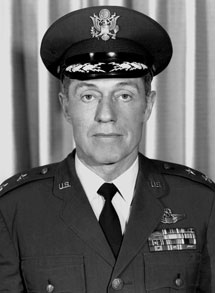
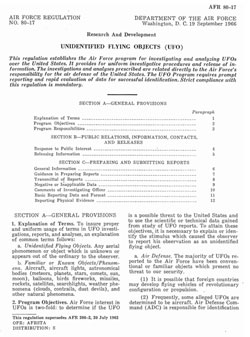
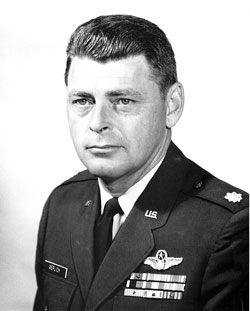

No comments:
Post a Comment